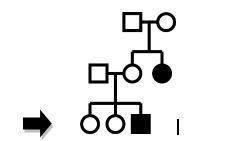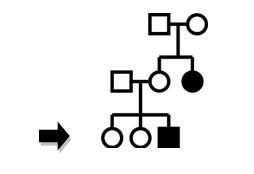
Concept explainers
Story on hemophilia
Part I. The family story
Olivia, a blond teen, is resoundingly beating her male tennis opponent, Ned. She is new in town and jokes that her partner went easy on her to make her feel welcome. From nowhere, a tennis ball cuts across their court. The dark-eyed brunette who hit it, Diana, stares at them. Olivia seems stunned into silence. Diana sneers at her and says, “Any day now.” Olivia hits the ball back to her, almost directly into her face.
“What was that all about? You know Diana Morrison?” Ned asks.
“I used to, back when I lived in Granville the first time,” Olivia answers. “Back then we were friends. It was like a million years ago.”
As they walk away, we hear Diana’s tennis coach screaming, “Diana, Diana! Somebody help Diana, please!”
“Is she OK? What’s happened?” Olivia gasps after running over. Diana has collapsed to the tennis court, not breathing.
“She just dropped unexpectedly,” Diana’s coach responds. “Call 911!”
Diana is taken by ambulance to the emergency room. Olivia follows by car. At the hospital, Olivia’s brunette mother walks in. “I went to the courts to pick you up and when you weren’t there, they said a girl had collapsed, I thought…” she stammers.
“I’m fine, Mom,” Olivia assures her. “I’m sorry for scaring you. I should have called. It’s Diana.”
“Diana Morrison?” her mother asks, alarm spreading across her face.
“Where’s Diana Morrison?” a blond woman who has just come in demands. “I’m her mother. They told me she was here.”
Olivia and her mother turn to stare at the new arrival.
“Olivia?” Diana’s mother asks. All three women stare at each other in confusion. “What are you doing here?”
“Mrs. Morrison, I was at the courts with Ned, and Diana was there, too, taking a lesson I guess.” Olivia explains. “She just collapsed.”
“Was it heat stroke?” Mrs. Morrison asks. “She barely ate any breakfast.”
Night has fallen in downtown Granville. A candle flickers over flowers and stuffed animals at a makeshift memorial. Diana’s mother is there comforting–and being comforted by—several young friends of her daughter.
Olivia approaches Mrs. Morrison and tries to speak to her, but Mrs. Morrison rebuffs her.
Olivia explains to her friend Ned, “When we were little our moms were such good friends, we did everything together. It was almost like we were sisters. Play dates, sports, camping, we even have the same birthdays so our parties were like this whole big deal every year.”
“What happened?” Ned asks.
“It just ended,” Olivia explains. “I remember one night I woke up and my Mom was in bed with me—she was rocking me and crying and crying. I asked her what was wrong, but all she would say was that she loved me.”
“And then after that, everything changed. Diana’s mom and dad split up. We stopped hanging out with them, and then we got transferred to Texas, or my Dad did, so we left,” Olivia shrugs. “My mom told me to forget about Diana, to make new friends. It was like she was mad at her, too.”
Olivia looks up and stares across the street. “What’s Dad doing here?”
Olivia’s father heads toward Mrs. Morrison, offering her comfort in an embrace.
Part I. A nurse’s narrative
A nurse is reminiscing with a colleague: “The day that Diana Morrison was born, there’d been this huge accident on the interstate. We were understaffed, overwhelmed. The bracelets must have come off in the bath. The charge nurse seemed confused. I asked if everything was OK. She ordered me to go to room 214 and get Mrs. Keller up and walking – now. I was fresh out of nursing school. I was trying to learn without asking too many questions. What could I do? I didn’t have any proof that the girls were switched. It was just a feeling. But, I did remember those girls’ names. I saw the mothers bonding, talking in the hallways, cradling their babies. When I saw Diana again 16 years later, I recognized her name when the paramedics brought her in.”
The nurse continues, “The circumstances of her death due to that blood clot – the thought of it made me wonder all over again. So, I pulled the girls’ medical records. That’s what confirmed it. You know, I’ve been trying to contact the families ever since. I’m determined to reach them because the blood clot that killed Diana sounds like it could be a genetic condition. It could affect someone else in her biological family. They have to be told.”
1. What is the pathway involved in blood clot formation? What are the possible disorders? How many types of hemophilia are there? What are their genetic causes? What are their inheritance patterns?
2. Below is the pedigree of one form of hemophilia. Which type of hemophilia can you rule out? (You should try to write out the genotype of each individual to see whether you can rule one out)

Trending nowThis is a popular solution!
Step by stepSolved in 4 steps with 1 images

- What do you think is going on with these two families? The hospital would have simple things like Diana’s blood type on file as below. Could you use blood type to figure it out?
Lisa Keller Kevin Keller Cynthia Morrison Mr. Morrison
A- O+ B+ O-
Olivia Keller Diana Morrison
O- A+
Come up with a hypothesis on what could have happened to this family? Show your pedigree and Punnett square.
- Below is the pedigree of one form of hemophilia. Which type of hemophilia can you rule out? (You should try to write out the genotype of each individual to see whether you can rule one out)

- What do you think is going on with these two families? The hospital would have simple things like Diana’s blood type on file as below. Could you use blood type to figure it out?
Lisa Keller Kevin Keller Cynthia Morrison Mr. Morrison
A- O+ B+ O-
Olivia Keller Diana Morrison
O- A+
Come up with a hypothesis on what could have happened to this family? Show your pedigree and Punnett square.
- Below is the pedigree of one form of hemophilia. Which type of hemophilia can you rule out? (You should try to write out the genotype of each individual to see whether you can rule one out)

- Elsa’s pediatrician suspects that she has thalassemia. Which of the following statements is true of thalassemia? Thrombocytes tend to “stick together” and form blood clots. Thalassemia is always caused by diet and environmental factors, not genetic makeup. Thalassemia is also known as erythroblastic anemia and involves a reduced amount of hemoglobin in the blood. Thalassemia is a type of hemophilia and is often hereditary in females.arrow_forwardREWRITE the dialogue to make it therapeutic A patient pulls his intravenous catheter out of his arm and is found with blood all over his arm and bed. The nurse comes into the room and says, “Look at this mess – why did you pull out your IV??”arrow_forwardplease help me, I am using this to study but I do not know if my answer is correct.arrow_forward
- Indicate whether the statement is true or false, and justify your answer.In a DRG payment system, hospitals receive payment according to the number of services rendered.arrow_forwardA/An _______________ vaccine does not induce sterilizing immunity and allow infection, replication and transmission additionally this type of vaccine allows the pathogen to evolvearrow_forwardAn ambulance emergency response team notifies an emergency room (ER) that they are 4 minutes away, with two females, ages 31 and 32, and a 32-year-old male, who have just been in an accident and have life-threatening injuries. They request a flight team to pick the patients up from the ER and take them to the nearest level 1 trauma center immediately. They also ask that a code response team be ready with as many units of blood as possible. The physician on staff orders all O negative units to be taken to the ER STAT. The hospital has only 3 0 negative units on hand, but they have 15 0 positive units, all of which are taken to the ER. The type and screens that were drawn in the ambulance are given to the phlebotomists as soon as the ambulance arrives at the hospital. The physician orders that the female who has the most life-threatening injuries should be given all of the O negative units, and the other female, who seems stable at the moment, is to be given 2 units of O positive RBCs.…arrow_forward
- Three medications that might be used to control bleedingarrow_forwardAntibodies are going to come in contact with an antigen and create an interaction. Please choose three and discuss what types of situations they would be present in.arrow_forwardNeutropenic fever- identifications and antibiotics coveragearrow_forward
 Human Anatomy & Physiology (11th Edition)BiologyISBN:9780134580999Author:Elaine N. Marieb, Katja N. HoehnPublisher:PEARSON
Human Anatomy & Physiology (11th Edition)BiologyISBN:9780134580999Author:Elaine N. Marieb, Katja N. HoehnPublisher:PEARSON Biology 2eBiologyISBN:9781947172517Author:Matthew Douglas, Jung Choi, Mary Ann ClarkPublisher:OpenStax
Biology 2eBiologyISBN:9781947172517Author:Matthew Douglas, Jung Choi, Mary Ann ClarkPublisher:OpenStax Anatomy & PhysiologyBiologyISBN:9781259398629Author:McKinley, Michael P., O'loughlin, Valerie Dean, Bidle, Theresa StouterPublisher:Mcgraw Hill Education,
Anatomy & PhysiologyBiologyISBN:9781259398629Author:McKinley, Michael P., O'loughlin, Valerie Dean, Bidle, Theresa StouterPublisher:Mcgraw Hill Education, Molecular Biology of the Cell (Sixth Edition)BiologyISBN:9780815344322Author:Bruce Alberts, Alexander D. Johnson, Julian Lewis, David Morgan, Martin Raff, Keith Roberts, Peter WalterPublisher:W. W. Norton & Company
Molecular Biology of the Cell (Sixth Edition)BiologyISBN:9780815344322Author:Bruce Alberts, Alexander D. Johnson, Julian Lewis, David Morgan, Martin Raff, Keith Roberts, Peter WalterPublisher:W. W. Norton & Company Laboratory Manual For Human Anatomy & PhysiologyBiologyISBN:9781260159363Author:Martin, Terry R., Prentice-craver, CynthiaPublisher:McGraw-Hill Publishing Co.
Laboratory Manual For Human Anatomy & PhysiologyBiologyISBN:9781260159363Author:Martin, Terry R., Prentice-craver, CynthiaPublisher:McGraw-Hill Publishing Co. Inquiry Into Life (16th Edition)BiologyISBN:9781260231700Author:Sylvia S. Mader, Michael WindelspechtPublisher:McGraw Hill Education
Inquiry Into Life (16th Edition)BiologyISBN:9781260231700Author:Sylvia S. Mader, Michael WindelspechtPublisher:McGraw Hill Education





